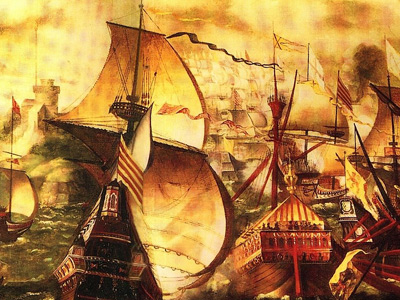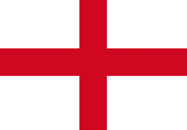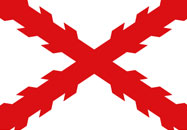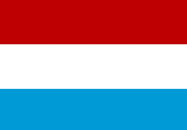Spanish Armada (1588)
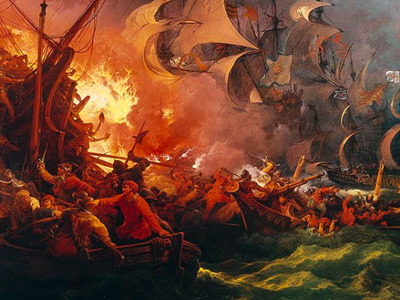
Background
Henry VIII began the English Reformation as a political exercise over his desire to divorce his first wife, Catherine of Aragon. Over time it became increasingly aligned with the Protestant reformation taking place in Europe, especially during the reign of Henry's son, Edward VI. Edward's death without an heir led to Henry's daughter Mary I taking the throne. A devout Catholic, Mary (with her co-monarch and husband, Philip II of Spain) began to reassert Roman influence over church affairs. Her attempts led to over 260 people being burned at the stake, earning her the nickname 'Bloody Mary'.
Mary's death in 1558 led to her half-sister, Elizabeth I, taking the throne. Unlike Mary, Elizabeth was firmly in the reformist camp, and quickly reimplemented many of Edward's reforms. Philip, no longer co-monarch, deemed Elizabeth a heretic and illegitimate ruler of England The Kingdom of England was a sovereign state on the island of Great Britain from about 927, when it emerged from various Anglo-Saxon kingdoms, until 1 May 1707, when it united with Scotland to form the Kingdom of Great Britain. The Viking invasions of the 9th century upset the balance of power between the English kingdoms, and native Anglo-Saxon life in general. The English lands were unified in the 10th century in a reconquest completed by King Æthelstan in 927.. Under Roman law, Henry had never officially divorced Catherine, making Elizabeth illegitimate. It is alleged that Phillip supported plots to have Elizabeth overthrown in favour of her Catholic cousin and heir presumptive, Mary, Queen of Scots; however, these were thwarted when Elizabeth had the Queen of Scots imprisoned and finally executed in 1587. Elizabeth retaliated against Philip by supporting the Dutch
The Kingdom of England was a sovereign state on the island of Great Britain from about 927, when it emerged from various Anglo-Saxon kingdoms, until 1 May 1707, when it united with Scotland to form the Kingdom of Great Britain. The Viking invasions of the 9th century upset the balance of power between the English kingdoms, and native Anglo-Saxon life in general. The English lands were unified in the 10th century in a reconquest completed by King Æthelstan in 927.. Under Roman law, Henry had never officially divorced Catherine, making Elizabeth illegitimate. It is alleged that Phillip supported plots to have Elizabeth overthrown in favour of her Catholic cousin and heir presumptive, Mary, Queen of Scots; however, these were thwarted when Elizabeth had the Queen of Scots imprisoned and finally executed in 1587. Elizabeth retaliated against Philip by supporting the Dutch The Dutch Republic was a confederation that existed from 1579, during the Dutch Revolt, to 1795. It was a predecessor state of the Netherlands and the first fully independent Dutch nation state. Although the state was small and contained only around 1.5 million inhabitants, it controlled a worldwide network of seafaring trade routes. The income from this trade allowed the Dutch Republic to compete militarily against much larger countries. It amassed a huge fleet of 2,000 ships, initially larger than the fleets of England and France combined. revolt against Spain
The Dutch Republic was a confederation that existed from 1579, during the Dutch Revolt, to 1795. It was a predecessor state of the Netherlands and the first fully independent Dutch nation state. Although the state was small and contained only around 1.5 million inhabitants, it controlled a worldwide network of seafaring trade routes. The income from this trade allowed the Dutch Republic to compete militarily against much larger countries. It amassed a huge fleet of 2,000 ships, initially larger than the fleets of England and France combined. revolt against Spain The Spanish Empire was a colonial empire governed by Spain and its predecessor states between 1492 and 1976. One of the largest empires in history, it was the first to usher the European Age of Discovery and achieve a global scale, controlling vast territory. It was one of the most powerful empires of the early modern period, reaching its maximum extent in the 18th century., as well as funding privateers to raid Spanish ships across the Atlantic.
The Spanish Empire was a colonial empire governed by Spain and its predecessor states between 1492 and 1976. One of the largest empires in history, it was the first to usher the European Age of Discovery and achieve a global scale, controlling vast territory. It was one of the most powerful empires of the early modern period, reaching its maximum extent in the 18th century., as well as funding privateers to raid Spanish ships across the Atlantic.
In retaliation, Philip planned an expedition to invade England in order to overthrow Elizabeth and reinstate Catholicism. Through this, it would end the English material support for the United Provinces – the part of the Low Countries that had successfully seceded from Spanish rule – and cut off English attacks on Spanish trade and settlements in the New World. The King was supported by Pope Sixtus V, who treated the invasion as a crusade, with the promise of a subsidy should the Armada make land.
A raid on Cadiz, led by Francis Drake in April 1587, had captured or destroyed some thirty ships and great quantities of supplies, setting preparations back by a year. Philip initially favoured a triple attack, starting with a diversionary raid on Scotland, while the main Armada would capture the Isle of Wight, or Southampton, to establish a safe anchorage in the Solent. The Duke of Parma would then follow with a large army from the Low Countries crossing the English Channel. Parma was uneasy about mounting such an invasion without any possibility of surprise. He was also alarmed by the costs that would be incurred and advised Philip to postpone or abandon it. The appointed commander of the Armada was the highly experienced Álvaro de Bazán, Marquis of Santa Cruz, but he died in February 1588, and the Duke of Medina Sidonia, a high-born courtier, took his place. While a competent soldier and distinguished administrator, Medina Sidonia had no naval experience. He wrote to Philip expressing grave doubts about the planned campaign, but this was prevented from reaching the King by courtiers on the grounds that God would ensure the Armada's success.
HISTORY
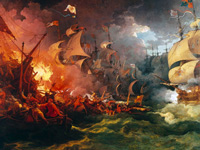
RESOURCES
This article uses material from the Wikipedia article "Spanish Armada", which is released under the Creative Commons Attribution-Share-Alike License 3.0.
© Stories Preschool. All Rights Reserved.
